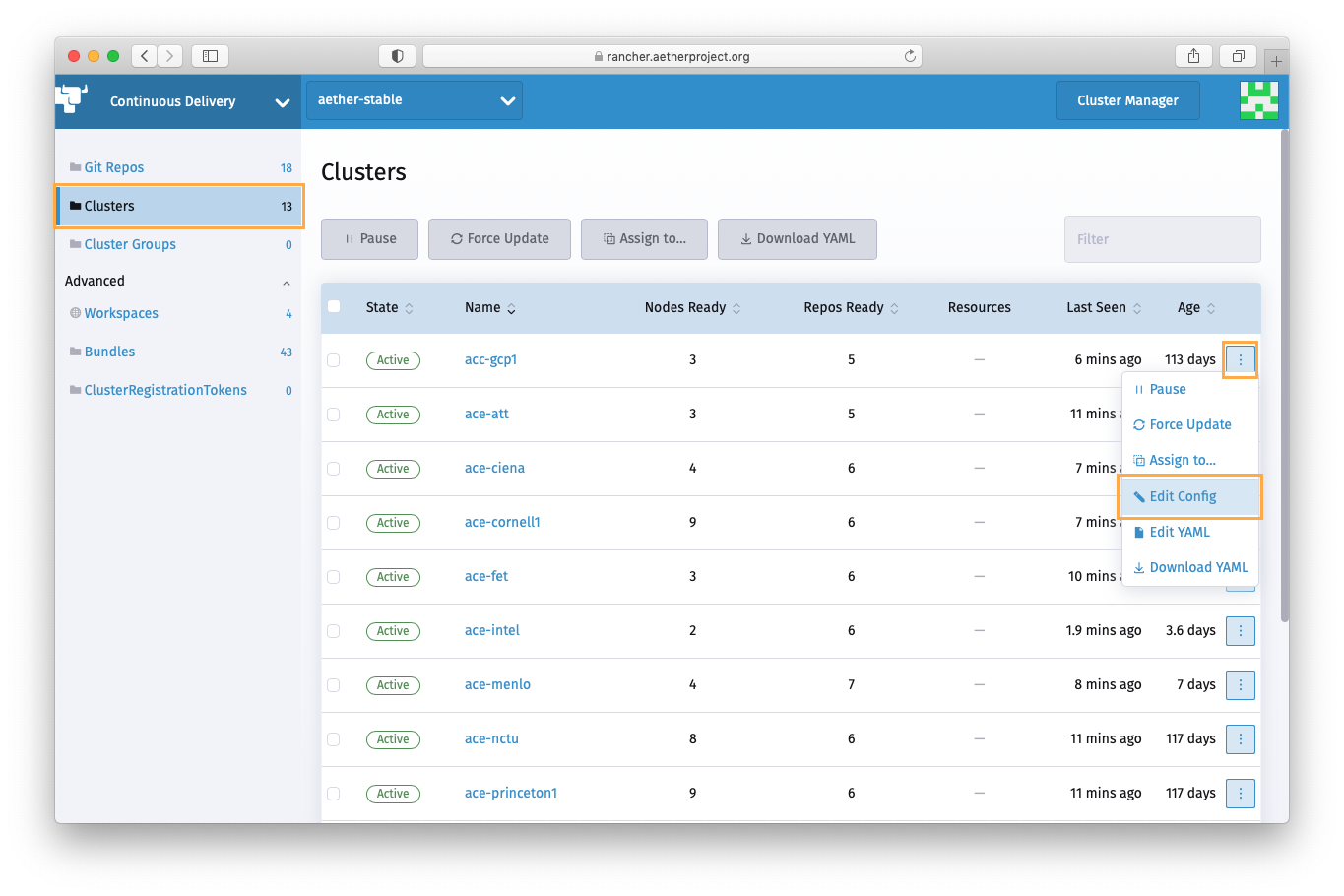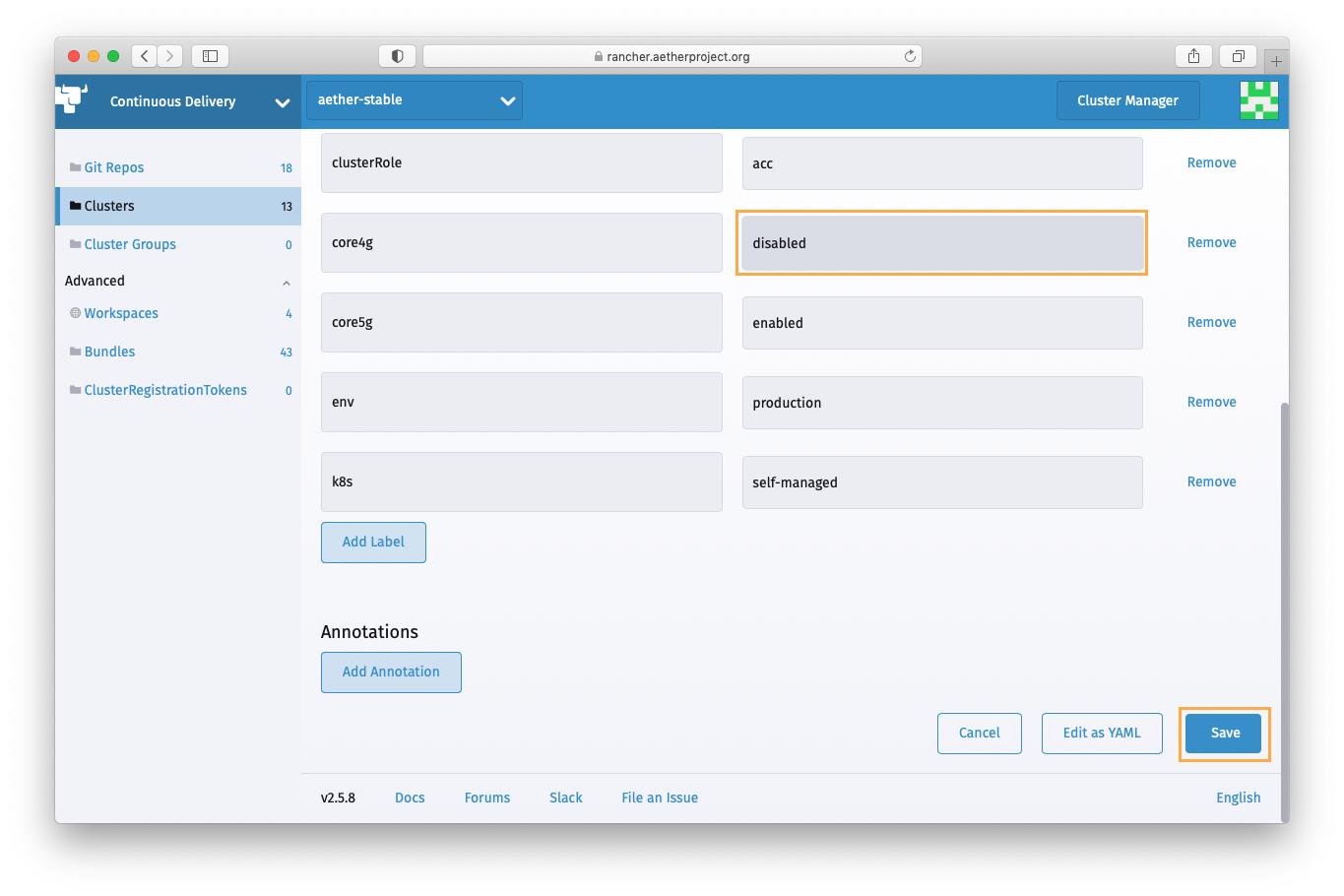Other Procedures
Edge shutdown procedure
To gracefully shutdown an Aether Edge Pod, follow the following steps:
Shutdown the fabric switches using
shutdown -h nowShutdown the compute servers using
shutdown -h nowShutdown the management server using
shutdown -h nowThe management switch and eNB aren’t capable of a graceful shutdown, so no steps need to be taken for that hardware.
Remove power from the pod.
Note
The shutdown steps can be automated with an ad-hoc ansible command and you have an ansible inventory of all the systems:
ansible -i inventory/sitename.ini -b -m shutdown -a "delay=60" all
The delay=60 argument is to allow hosts behind the management server to
be reached before the management server shuts down.
Edge power up procedure
Restore power to the pod equipment. The fabric and management switches will power on automatically.
Turn on the management server using the front panel power button
Turn on the compute servers using the front panel power buttons
Restore stateful application procedure
Note
PersistentVolumeClaim/PersistentVolume backup and restore is currently only available for ACC and AMP clusters.
Download and install Velero CLI following the official guide. You’ll also need
kubectlandhelmcommand line tools.Download the K8S config of the target cluster from Rancher to your workstation.
Open Rancher Continuous Delivery > Clusters dashboard, find the cluster the target application is running on, and temporarily update the cluster label used as the target application’s cluster selector to uninstall the application and prevent it from being reinstalled during the restore process. Refer to the table below for the cluster selector labels for the Aether applications. It may take several minutes for the application uninstalled.
Application
Original Label
Temporary Label
cassandra
core4g=enabled
core4g=disabled
mongodb
core5g=enabled
core5g=disabled
roc
roc=enabled
roc=disabled


Clean up existing PVC and PV for the application. In this guide, Cassandra is used as an example.
# Assume that we lost all HSSDB data
$ kubectl exec cassandra-0 -n aether-sdcore-4g -- cqlsh $cassandra_ip -e 'select * from vhss.users_imsi'
<stdin>:1:InvalidRequest: code=2200 [Invalid query] message="Keyspace vhss does not exist"
# Confirm the application is uninstalled after updating the cluster label
$ helm list -n aether-sdcore-4g
(no result)
# Clean up any remaining resources including PVC
$ kubectl delete ns aether-sdcore-4g
# Clean up released PVs if exists
$ kubectl delete pv $(kubectl get pv | grep cassandra | grep Released | awk '$1 {print$1}')
Find a backup to restore.
# Find the relevant backup schedule name
$ velero schedule get
NAME STATUS CREATED SCHEDULE BACKUP TTL LAST BACKUP SELECTOR
velero-daily-cassandra Enabled 2021-10-11 15:33:30 -0700 PDT 0 7 * * * 720h0m0s 11h ago app=cassandra
velero-daily-mongodb Enabled 2021-10-11 15:33:30 -0700 PDT 0 7 * * * 720h0m0s 11h ago app.kubernetes.io/name=mongodb
velero-daily-opendistro-es Enabled 2021-10-11 15:33:30 -0700 PDT 0 7 * * * 720h0m0s 11h ago app=opendistro-es
velero-daily-prometheus Enabled 2021-10-11 15:33:30 -0700 PDT 0 7 * * * 720h0m0s 11h ago app=prometheus
# List the backups
$ velero backup get --selector velero.io/schedule-name=velero-daily-cassandra
NAME STATUS ERRORS WARNINGS CREATED EXPIRES STORAGE LOCATION SELECTOR
velero-daily-cassandra-20211012070020 Completed 0 0 2021-10-12 00:00:41 -0700 PDT 29d default app=cassandra
velero-daily-cassandra-20211011070019 Completed 0 0 2021-10-11 00:00:26 -0700 PDT 28d default app=cassandra
...
# Confirm the backup includes all the necessary resources
$ velero backup describe velero-daily-cassandra-20211012070020 --details
...
Resource List:
v1/PersistentVolume:
- pvc-50ccd76e-3808-432b-882f-8858ecebf25b
- pvc-67f82bc9-14f3-4faf-bf24-a2a3d6ccc411
v1/PersistentVolumeClaim:
- aether-sdcore-4g/data-cassandra-0
- aether-sdcore-4g/data-cassandra-1
- aether-sdcore-4g/data-cassandra-2
Update the backup storage location to read-only mode to prevent backup object from being created or deleted in the backup location during the restore process.
$ kubectl patch backupstoragelocations default \
--namespace velero \
--type merge \
--patch '{"spec":{"accessMode":"ReadOnly"}}'
Create a restore with the most recent backup.
# Create restore
$ velero restore create --from-backup velero-daily-cassandra-20211012070020
# Wait STATUS become Completed
$ velero restore get
NAME BACKUP STATUS STARTED COMPLETED ERRORS WARNINGS CREATED SELECTOR
velero-daily-cassandra-20211012070020-20211012141850 velero-daily-cassandra-20211012070020 Completed 2021-10-12 13:11:20 -0700 PDT <nil> 0 0 2021-10-12 13:11:20 -0700 PDT <none>
Confirm that PVCs are restored and “Bound” to the restored PV successfully.
$ kubectl get pvc -n aether-sdcore
NAME STATUS VOLUME CAPACITY ACCESS MODES STORAGECLASS AGE
data-cassandra-0 Bound pvc-50ccd76e-3808-432b-882f-8858ecebf25b 10Gi RWO standard 45s
data-cassandra-1 Bound pvc-67f82bc9-14f3-4faf-bf24-a2a3d6ccc411 10Gi RWO standard 45s
data-cassandra-2 Bound pvc-a7f055b2-aab1-41ce-b3f4-c4bcb83b0232 10Gi RWO standard 45s
Revert the backup storage location to read-write mode.
kubectl patch backupstoragelocation default \
--namespace velero \
--type merge \
--patch '{"spec":{"accessMode":"ReadWrite"}}'
Revert the cluster label to the original and wait Fleet to reinstall the application. It may take several minutes.
# Confirm the application is installed
$$ kubectl get po -n aether-sdcore-4g -l app=cassandra
NAME READY STATUS RESTARTS AGE
cassandra-0 1/1 Running 0 1h
cassandra-1 1/1 Running 0 1h
cassandra-2 1/1 Running 0 1h
# Confirm the data is restored
$ kubectl exec cassandra-0 -n aether-sdcore -- cqlsh $cassandra_ip -e 'select * from vhss.users_imsi'
...
(10227 rows)